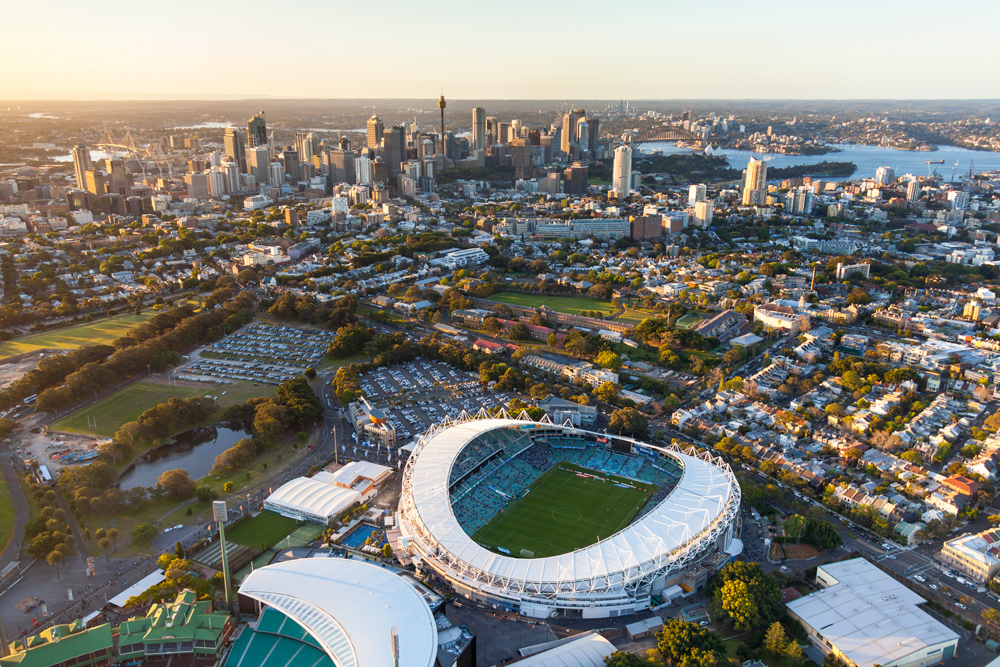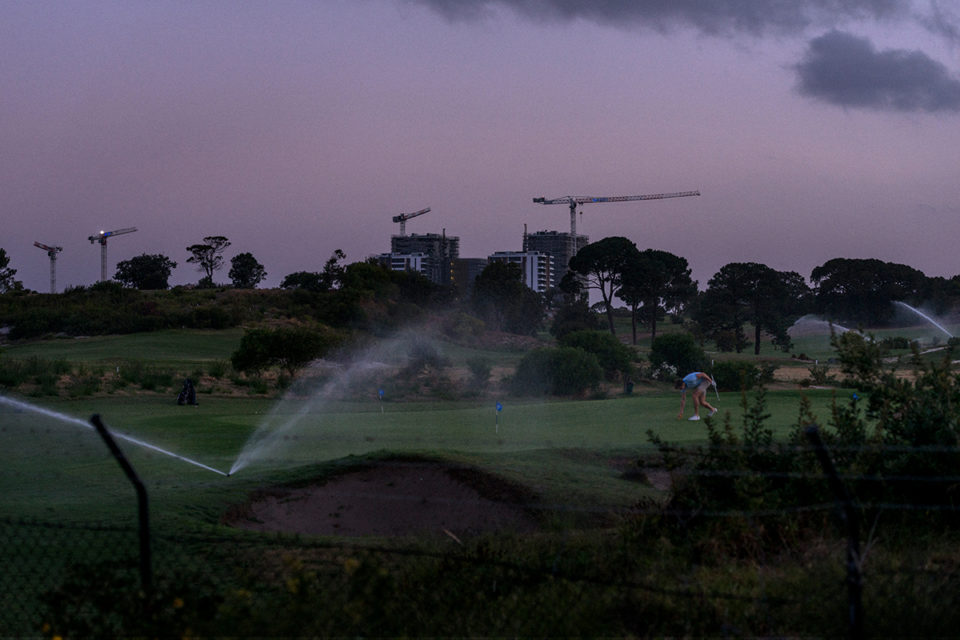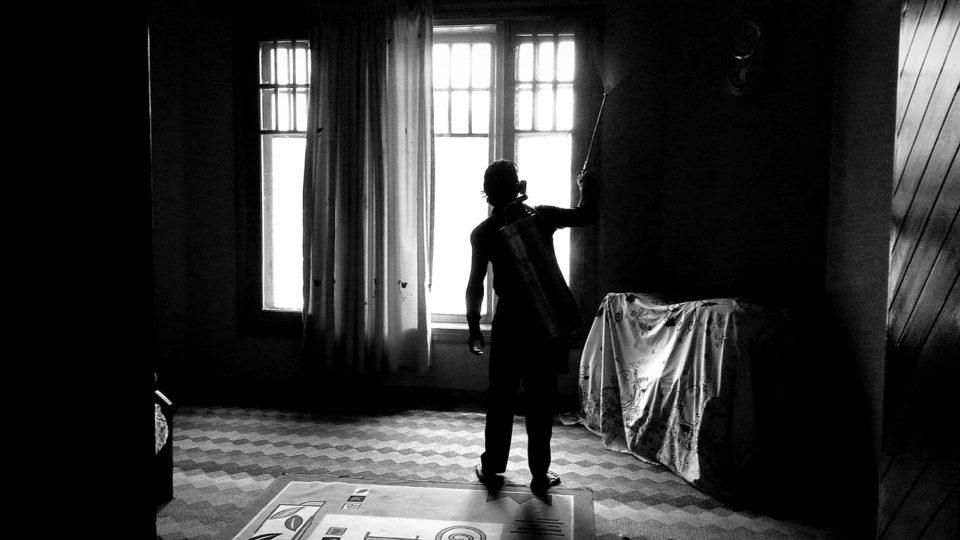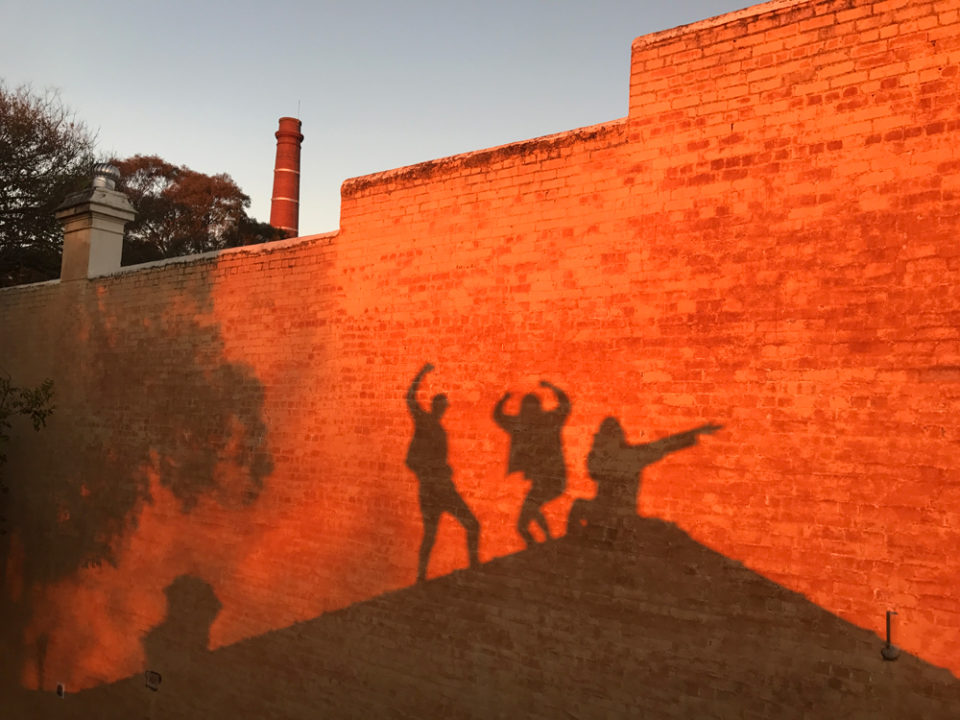The Sydney Football Stadium, as it was then known, opened its 40,000 public seats and 200 corporate boxes to the plebs, the sporting elite and their corporate tagalongs on the day of the Bicentenary, 26 January 1988.
The doyenne of the Australian Anthem circuit, Julie Anthony, belted out the national myth of boundless plains to share and Gordon Bray interjected with characteristic mellifluousness on the beauty of the spectacle, as it rolled on into the evening.
The new stadium was completed on time and on budget by Civil and Civic Pty Ltd in under two years, with an award-winning ‘saddle’ roof design by Philip Cox & Partners that melds with the surrounding parklands.
Almost 30 years later and after much backroom jostling, the NSW Liberal government has decided to tear down the once iconic stadium, which now bears the name of insurer Allianz.
They will raze Allianz Stadium and rebuild it at the starting cost of $705 million between 2018-21 as part of a $2.5 billion spend on sporting ‘stadia’.
The spend includes rebuilding ANZ Stadium at Olympic Park as a rectangular playing field and completing the 30,000 capacity Western Sydney Stadium (now under construction in the footprint of the old Parramatta Stadium and what was a public pool).
Minister for Sport Stuart Ayres has been busy countering claims the government would be better off spending the money on schools and hospitals or community sporting facilities or not at all.
Premier Berejiklian noted that health and education receive $200 billion under current budgetary arrangements over the same period, a robust estimate that adds in recurrent costs, like wages, and capital investment. “In simple terms,” Ayres told The Daily Telegraph, “that means we think health and education is 100 times more important than stadiums.”
If comparisons are helpful, the investment in stadiums dwarfs the government’s $1.1 billion commitment to social and affordable housing. Stadia investment is meanwhile being funded entirely by the controversial privatisation of NSW Land and Property Information, the public service responsible for the property and ownership records that secure the state’s $1.5 trillion of land wealth.
At a December business breakfast at the Four Seasons Hotel, the NSW Treasurer Dominic Perrottet announced a $600 million increase in the expected budget surplus for 2017-18 to $3.3 billion. In the characteristic attire of a Mosman realtor, the Treasurer reaffirmed the government’s commitment to “schools and stadiums.”
Unlike the state’s crowded public school system, Allianz Stadium and ANZ Stadium average around 30 and 10 percent capacity, respectively, on game days. There’s an arithmetic lesson in here somewhere.
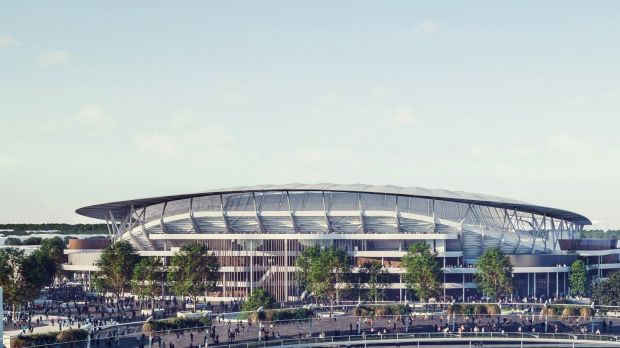
An artist’s impression of the proposed Allianz Stadium on SCG Trust land. Government Supplied.
It’s not just cricket
The reason why the government is proposing to allocate enough money to rebuild the permanently under-capacity Allianz Stadium has a lot to do with another ‘public’ body – the Sydney Cricket & Sports Ground Trust, which has enjoyed the long-running support of Sports Minister Stuart Ayres.
“This is how power is exercised in NSW,” began Sydney Lord Mayor Clover Moore’s opinion piece in the Sydney Morning Herald following the stadia announcement. “The public interest is being steamrolled by an all-powerful SCG Trust and an ambitious sports minister who wants to play with the big boys,” she wrote.
From behind the unremarkable glass facade of the Sheridan Building on Moore Park Road, the SCG Trust wields immense influence. The board of Trustees is a nest of local big-end-of-towners, sporting greats, media heavies and jilted ex-premiers.
Trustees include 2GB broadcaster Alan Jones (nearing a 30-year reign), former WestConnex chief and Transfield boss Tony Shepherd AO, former News Ltd CEO John Hartigan, former chairman of the ASX Maurice Newman AC and former premier Barry O’Farrell.
“They’re crash or crash through type of people,” says the president of Saving Moore Park Inc., Michael Waterhouse. “If you’re on a board it’s always much easier if when you pick up the phone to call the minister he picks up. That happens for the SCG Trust board.”
The maneuvering of Ayres and the Trust in the so-called ‘stadium wars’ has its genesis in 2015, when the Baird government announced $1.6 billion in stadium funding to be allocated in order of a stadium’s age. This would put the 30-year-old Allianz, controlled by the SCG Trust, in front of ANZ Stadium at Olympic Park, which is now under the control of Venues NSW.
Subsequently, the SCG Trust spent $5.8 million on a concept design by architects Populous that situated the new stadium on Kippax Lake – a strip of historic parkland controlled by the Centennial Park and Moore Park Trust.
Ayres was later accused by tenant clubs – the Roosters, Sydney FC and the NSW Waratahs – of promising something he couldn’t deliver: a new stadium on the open green space of Moore Park. If it had eventuated, in line with the SCG Trust’s ‘whole of precinct’ concept, home matches would have been playable at the existing Allianz Stadium during the new stadium’s construction.
“In the past he [Ayres] has shown a complete disregard for the value of Moore Park,” says Michael Waterhouse of Saving Moore Park Inc. whose organisation owes its inception to the Kippax Lake proposal.
Ever since the Albert ‘Tibbey’ Cotter Walkway appeared over Anzac Parade in 2015, fears of a secret plan to encroach upon the open green space at Moore Park has worried parkland defenders, who count powerful figures such as Member for Wentworth, Malcolm Turnbull, in their company.
The ABC’s Background Briefing program brought in an engineer to show how the supposed “walkway”, a legacy of Barry O’Farrell’s premiership, was designed to specification as a vehicle bridge – one that could connect a stadium entrance at Kippax Lake to a carpark at Moore Park West. It sits conspicuously unused, its $38 million price tag dangling in the wind. Barry O’Farrell now occupies a seat on the Trust.
By April 2016 it became apparent that there was little desire from the codes and the resident clubs to demolish and rebuild Allianz on the same site, which would mean losing the ground for at least three seasons. With the idea of encroaching onto public parkland also a non-starter, Baird followed the path of reason and redirected the funds west against his sports minister’s wishes.
A rectangular stadium at Olympic Park would be best suited for its popular use as a venue for rugby league, rugby union and A-League matches. Under that plan, any funds remaining would then be made available to the SCG Trust to refurbish Allianz, which needs around $137 million to remedy safety and security issues at the stadium (concerns heightened by the November 2015 Paris bombing attacks at Stade de France during a match between France and Germany).
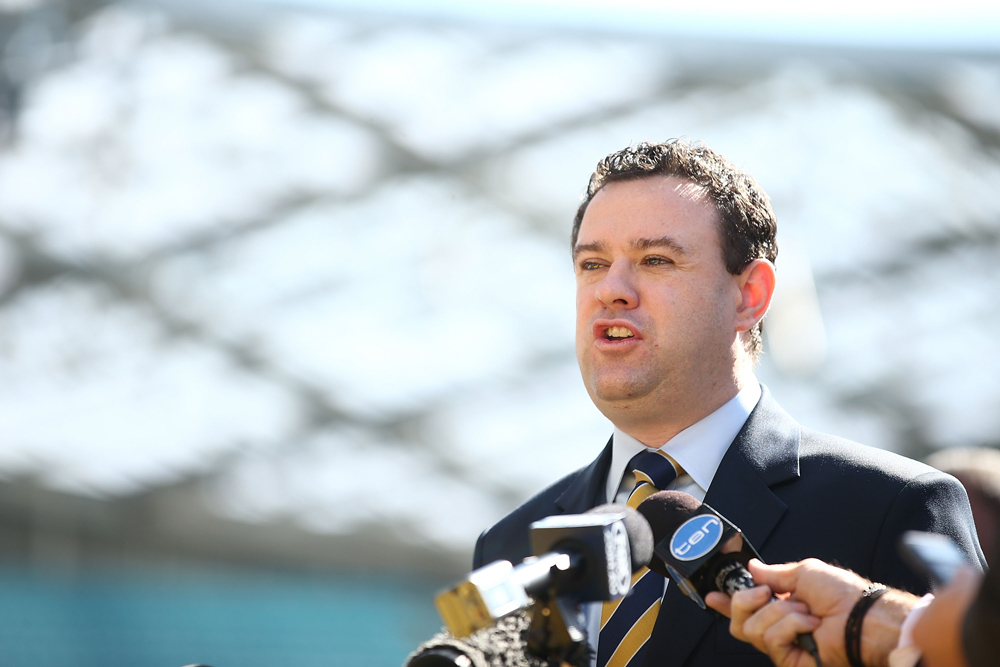
Sports Minister Stuart Ayres at an NRL press conference in September. Photo credit: Mark Metcalfe/Getty Images
Despite Premier Baird overruling his sports minister, the ‘stadium wars’ did not cease. Baird’s own crusade against greyhound racing steadily collapsed after being belted on air by Alan Jones. He finally relented on banning the sport. Politically wounded, Baird would resign in January 2017 citing family health matters.
Upon Mike Baird’s resignation the idea for a brand new stadium at Moore Park reemerged. The SCG Trust and Ayres seized on a timely series of leaked documents which showed considerable safety and security concerns at Allianz, as well as a patently inadequate number of women’s toilets. Happily for the SCG Trust, there was also an implication of cost-blowouts at ANZ Stadium, the NRL’s first priority.
“We recognise the government hasn’t got a bottomless pit of money and it’s a question of whatever their priorities are,” said the even-handed chairman of the SCG Trust, Tony Shepherd, in mid-2017.
Skip forward to 27 November 2017 and we find Premier Gladys Berejiklian standing in the Domain flanked by her sport minister, Ayres, the chief executives of the major football codes, the SCG Trust’s Tony Shepherd and the chair of Venues NSW, Christine McLoughlin. They’ve gathered to announce a funding increase of $1.6 to $2.5 billion to demolish and rebuild Allianz, ANZ and Parramatta stadiums.
First cab off the rank will be Allianz Stadium, the SCG Trust’s priority. Work will begin in 2018 at a starting cost of $705 million, safely before the 2019 state election. A Labor victory before the project’s commencement would have blocked the Trust’s ambitions for rebuilding Allianz.
“This has very little, if anything, to do with sport,” Opposition Leader Luke Foley told Neighbourhood. “If you take the Government’s logic to the extreme it means you’d demolish the SCG, and replace it from scratch.”
It remains unclear how the government secured the backing of the football codes and especially the three teams affected across rugby league, football and rugby union – the Roosters, Sydney FC and the NSW Waratahs, respectively. The SCG will host Roosters games in the interim and it is likely other tenants will follow suit during the four-year construction period.
On Tuesday, the NSW government announced it would contribute $50 million to seven NRL clubs to fund “centres of excellence”, with the Sydney Roosters receiving $5.76 million of the total allocation, behind Cronulla, South Sydney, Newcastle and Manly who received greater amounts.
As details continue to emerge, the cost of the complete stadia package to the state has grown to nearly $1 billion.
The thrill of the game
At the time of writing, an online petition for the government to reverse its decision to allocate $2 billion to rebuild Allianz and ANZ stadiums, started by swashbuckling Australiaphile and Fairfax columnist Peter FitzSimons, has almost 150,000 digital signatures.
“We are tired of taxpayer dollars being lavished on building facilities for Sports Big Business while community sport withers on the vine for lack of facilities and resources,” FitzSimons’ petition states.
As public opinion has continued to recoil on the government, some of its ministers have been in contortions to justify the decision on economic grounds, without releasing any of its own figures to support the allocation.
“All too often governments shy away from good long-term decision making. Afraid of the cost, the backlash, the vested interests and that’s without even talking about the politics,” Ayres told The Daily Telegraph.
The Daily Telegraph has since come into the possession of “confidential financial modelling” that shows rebuilding ANZ Stadium at Olympic Park would be cheaper than a refurb job. Details were scarce and nothing in the modelling seemed to justify doing the same to Allianz Stadium at Moore Park. So long as everyone is happy and a cursory nod given to economic reason, it doesn’t appear to matter if it’s millions or billions of dollars.
“Imagine what the State Government could do with the SCG if it got a decent run at it,” observed radio personality H.G Nelson, AKA Greig Pickhaver on Twitter. “20 stories of apartments at square leg, parking for 6,500 cars at point and a shopping mall from third leg to mid off.”
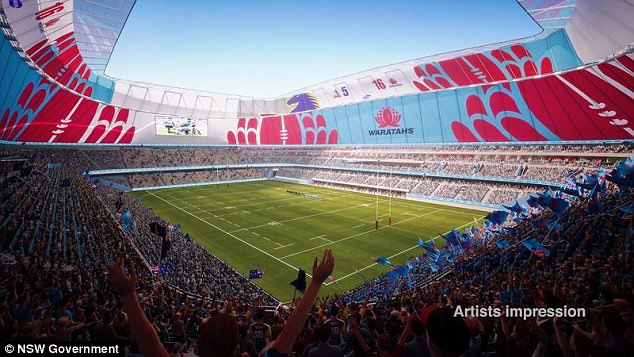
An artist’s impression of proposed Allianz Stadium during a Waratah’s game. Credit: NSW Government
To muted applause, the SCG Trust has achieved what it fundamentally thought to be the best outcome – a new stadium at Moore Park – cementing the stadium and the Trust’s place in the city’s elite sporting geography.
Once again, the inner city public appears to have avoided the loss of a significant portion of the park’s open green space and the historic Kippax Lake, having withstood land-grabs by the Trust in the past.
In addition, “there will be no site compound in Moore Park, so the Park won’t be affected during construction,” says Michael Waterhouse of Saving Moore Park Inc. who received an “absolute cast iron guarantee from the Trust” on the matter. When Neighbourhood called Minister Ayres’ office, a spokesperson confirmed the new stadium would be constructed entirely on on the SCG Trust’s own land. In what will require a feat of match scheduling, the SCG, which is also controlled by the Trust, will now play host to every football code there is plus the cricket.
Victorious, the chairman of the SCG Trust Tony Shepherd’s op-ed in the Sydney Morning Herald tried to level with the people of New South Wales about who the real winners were. Knocking down and rebuilding Allianz Stadium will give “[the] sporting public a facility they deserve and can be proud of,” Shepherd wrote, comparing the ageing stadium to the since-departed Monorail, another ‘80s wreck.
Without moving mountains of steel and concrete and churning through the state’s consolidated revenue, the Trustees of the Sydney Cricket & Sports Ground Trust would have become spectators to the city’s footballing glory transferring to the western suburbs (something it may do regardless).
Deprived of the thrill of advising on a flashy new stadium development, they’d need to make do with the more mundane honours of a public advisory board – deciding what Australian batsman to immortalise in bronze, attending the odd committee meeting and unveiling a plaque or two with some minor royalty.
And where is the sport in that?


